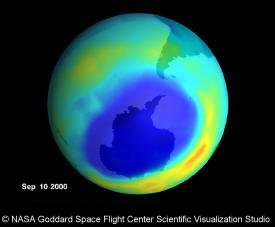Environment - The Ozone Layer

Although ozone (O3) is present in small concentrations throughout the atmosphere, most ozone (about 90%) exists in the stratosphere, in a layer between 10 and 50km above the surface of the earth. This ozone layer performs the essential task of filtering out most of the sun's biologically harmful ultraviolet (UV-B) radiation. Concentrations of ozone in the atmosphere vary naturally according to temperature, weather, latitude and altitude. Furthermore, aerosols and other particles ejected by natural events such as volcanic eruptions can have measurable impacts on ozone levels.
In 1985, scientists identified a thinning of the ozone layer over the Antarctic during the spring months which became known as the "ozone hole". The scientific evidence shows that human-made chemicals are responsible for the creation of the Antarctic ozone hole and are also likely to play a role in global ozone losses. Ozone Depleting Substances (ODS) have been used in many products which take advantage of their physical properties (e.g. chlorofluorocarbons (CFCs) have been used as aerosol propellants and refrigerants).

0 Comments:
Post a Comment
<< Home